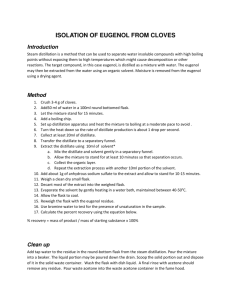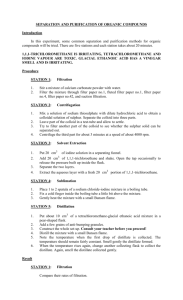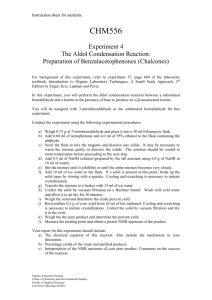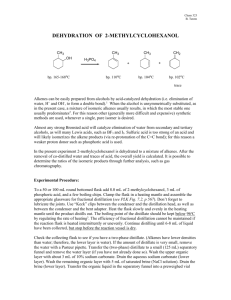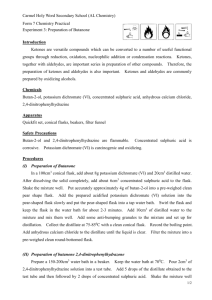chem_lab
advertisement
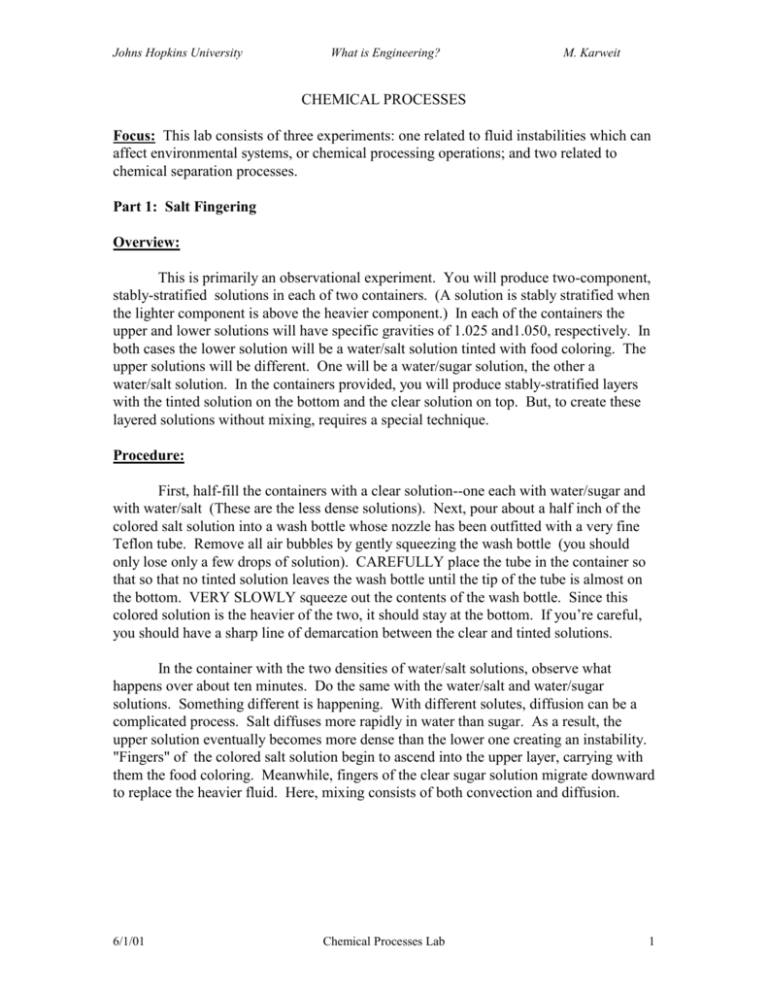
Johns Hopkins University What is Engineering? M. Karweit CHEMICAL PROCESSES Focus: This lab consists of three experiments: one related to fluid instabilities which can affect environmental systems, or chemical processing operations; and two related to chemical separation processes. Part 1: Salt Fingering Overview: This is primarily an observational experiment. You will produce two-component, stably-stratified solutions in each of two containers. (A solution is stably stratified when the lighter component is above the heavier component.) In each of the containers the upper and lower solutions will have specific gravities of 1.025 and1.050, respectively. In both cases the lower solution will be a water/salt solution tinted with food coloring. The upper solutions will be different. One will be a water/sugar solution, the other a water/salt solution. In the containers provided, you will produce stably-stratified layers with the tinted solution on the bottom and the clear solution on top. But, to create these layered solutions without mixing, requires a special technique. Procedure: First, half-fill the containers with a clear solution--one each with water/sugar and with water/salt (These are the less dense solutions). Next, pour about a half inch of the colored salt solution into a wash bottle whose nozzle has been outfitted with a very fine Teflon tube. Remove all air bubbles by gently squeezing the wash bottle (you should only lose only a few drops of solution). CAREFULLY place the tube in the container so that so that no tinted solution leaves the wash bottle until the tip of the tube is almost on the bottom. VERY SLOWLY squeeze out the contents of the wash bottle. Since this colored solution is the heavier of the two, it should stay at the bottom. If you’re careful, you should have a sharp line of demarcation between the clear and tinted solutions. In the container with the two densities of water/salt solutions, observe what happens over about ten minutes. Do the same with the water/salt and water/sugar solutions. Something different is happening. With different solutes, diffusion can be a complicated process. Salt diffuses more rapidly in water than sugar. As a result, the upper solution eventually becomes more dense than the lower one creating an instability. "Fingers" of the colored salt solution begin to ascend into the upper layer, carrying with them the food coloring. Meanwhile, fingers of the clear sugar solution migrate downward to replace the heavier fluid. Here, mixing consists of both convection and diffusion. 6/1/01 Chemical Processes Lab 1 Johns Hopkins University What is Engineering? M. Karweit Write-up: This is essentially an observation lab--describe the two experiments and what you see. Would it work for very large or very small density differences? How long does it take for the salt fingers to penetrate to the top? Do they reach the very top? Try to estimate the average distance between the fingers. Part 2: Paper Chromatography Overview: Chromatography separates different chemical substances—in this case colored dyes--by making use of their different flow rates while being transported by a diffusing solvent. Flow rates are defined as being the distance a solute (a chemical substance) travels divided by the distance traveled by the solvent. For example, one color in a solvent may move farther than another color in the same solvent even if they are given the same length of time to move. If the end of a piece of absorbent paper with an ink pen line on it is placed in solvent, the solvent will be drawn up the surface of the paper by capillary action. As it passes the ink line, the ink will dissolve in the solvent and be carried along with the solvent (this is mass transport). The ink, though, will be differentially retarded by the paper. A competition for ink is set up between the solvent and the paper, and as a result, the ink will travel up the surface of the paper more slowly than the solvent. The relative strength of the ink’s attraction for the paper and solvent varies between inks. If there is more than one ink in a given pen, each ink will travel at its own pace, and you will see each separate ink emerge. In addition, some solvents will dissolve certain inks better than others. When solvents are used that do not dissolve the ink well, most of the ink will be left behind at the original line and only a small amount will travel up the paper. Procedure: You will be given three pieces of filter paper (a coffee filter could have been used) that you should cut into rectangles about 4cm x 10 cm. Using the three pens provided, make a line segment about 0.75cm long with each of the pens about 1 cm from one end of the each paper strip. The distance between marks should be about 0.75cm; the end result should be a dashed line where each line segment has been made with a different pen. Make multiple passes so the ink is dark. Put several lines of the same color directly on top of each other rather than overlapping them. The objective is to provide sources of dye which can diffuse up the length of the strips. Let the ink dry while you make a horizontal pencil mark connecting the two ink lines and extending beyond them. Make another pencil mark near the other end of the strip. These will mark the end point of the experiment. 6/1/01 Chemical Processes Lab 2 Johns Hopkins University What is Engineering? M. Karweit You will be conducting nine separate experiments: three with water as a solvent, three with methanol(POISON) as a solvent, and three with 2-propanol(POISON). Each of the ink marks is its own separate experiment. First pour solvent into the developing tank to a depth of about 1 cm. Attach the plain end of your prepared paper strip to a straightened paper clip. This wire will be used to suspend the filter paper over the solvent. Lower the paper into the solvent to a depth of 2-3mm, but not so deep that the ink marks are in the solvent. Cover the tanks with a piece of paper to minimize evaporation. The solvent will rise, partially carrying the ink. Once the solvent reaches the pencil mark (which won’t dissolve in the solvents), remove the paper strip from the tank and let it dry. Measure the farthest excursions of all ink lines on this “chromatogram”. The ratio of the distance traveled by the ink to the distance traveled by the solvent is the flow rate for that ink in that solvent. Perform this experiment with water, methanol, and 2-propanol as solvents. Write-up: First, describe what happened, taking care to differentiate between different colors and different solvents. For the methanol and 2-propanol experiments, calculate flow rates from the purple ink and present a graph showing the flow rate of each component as a function of the proportion of 2-propanol in the solvent (approximately 100% for 2propanol and 0% for methanol). Assuming that flow rate changes linearly with 2propanol concentration, draw a line which represents the expected flow rate for each component in various concentrations. Deduce the expected equations of each of these lines. Notice that for the purple pen, one ink component flows faster in 2-propanol while the other flows faster in methanol. If we were attempting to separate these two components, and we were really unlucky by choosing the wrong concentration of methanol, we could obtain no separation. Estimate the methanol concentration in 2propanol of this most undesirable solvent? Part 3: Distillation Overview: The objective of this experiment is to apply the process of distillation to a mixture of ethanol and water in order to obtain a new mixture with an increased concentration of ethanol. In addition, the results of the experiment will be used to approximate the equilibrium relationship between ethanol and water. Distillation has been described as the “work-horse” of chemical engineering because of its widespread use in industry. Distillation is a type of separation process that is useful in separating components of a liquid mixture that have different boiling points. 6/1/01 Chemical Processes Lab 3 Johns Hopkins University What is Engineering? M. Karweit For example, consider a mixture consisting of two components, A and B, that have boiling points of 70°C and 100°C, respectively. When the mixture begins to boil, the vapor phase that is formed will be richer in A than the liquid phase. This is because A has a lower boiling point and vaporizes more easily than B. Therefore, A has a greater tendency to enter the vapor phase while B tends to remain in the liquid phase. Of course, if the entire mixture were allowed to boil away, the resulting vapor would have the same concentration of A and B as the original liquid mixture. However, if only a fraction of the liquid is allowed to boil, the vapor will contain a higher concentration of A than the original liquid mixture. As the mixture continues to boil, the compositions of both the vapor and liquid phases change with time. Since A enters the vapor phase more quickly than B, the concentration of A in the liquid phase decreases while that of B increases. Also, as the temperature of the boiling liquid increases, more B vaporizes as time passes, and the concentration of B in the vapor phase also increases with time. If some fraction of the original mixture vaporizes and the vapor is collected and allowed to cool and condense in a separate container, the new liquid mixture will have a higher concentration of A than the original did. With each repetition of this process, we would obtain a new liquid mixture with a higher A concentration than the previous mixture. This is basically how distillation works. It is just a series of vaporization and condensation processes that continues until a desired concentration is reached. In general, an equilibrium stage in any type of unit operation process is defined as an area in which different phases are brought into close contact so that a component can be redistributed between the phases to equilibrium concentrations. In the simple batch distillation setup in this experiment, liquid in the 1000-mL flask is in close contact with the vapor phase that forms as the mixture boils, and this is the only place where this situation is present in the setup. Therefore, there is one equilibrium stage in this batch distillation. Assuming everything works ideally, the vapor phase is in equilibrium with the liquid in the flask at any given time. The type of equilibrium information that is needed for analyzing this separation process is that which shows the vapor-liquid equilibrium relationship for an ethanol/water mixture. The most useful representation of the data is a y versus x graph, where y and x are the vapor and liquid phase concentrations, respectively, of the more volatile component, ethanol. Points on the curve depicted in such a graph represent the concentration of ethanol in the vapor and liquid phases at equilibrium. Along the equilibrium curve, pressure is constant, but temperature is different at each point. A picture of the ethanol/water y versus x graph is shown below. 6/1/01 Chemical Processes Lab 4 Johns Hopkins University What is Engineering? M. Karweit 100 90 80 vapor mole % ethanol 70 60 50 40 30 20 10 0 0 10 20 30 40 50 60 70 80 90 100 liquid mole % ethanol Procedure: This experiment is a small-scale batch distillation. The basic setup is shown below. f. e. a. b. c. d. e. f. g. h. g. d. c. h. i. j. i. b. ringstand to support flask hot plate 1000-mL flask clamp to secure flask rubber stopper copper tubing ice bath for copper tubing clamp to support ice bath and tubing distillate collection beaker ringstand to support ice bath and tubing j. a. 6/1/01 Chemical Processes Lab 5 Johns Hopkins University What is Engineering? M. Karweit The original ethanol/water solution is placed in the 1000-mL flask. Heat to the mixture is provided by a hot plate. A rubber stopper caps the flask, and it contains a small hole through which a piece of copper tubing is inserted. The long piece of tubing coils downward through an ice bath, and its purpose is to carry vapors away from the flask and allow them to cool and condense to the liquid phase. (The condensed liquid is referred to as distillate.) The condensed liquid empties into a beaker at the bottom of the coil. During the experiment, you will allow the flask mixture to boil. Vapors produced from boiling will escape the flask through the copper tubing and will condense in the cooled, coiled part of the tubing forming the distillate. The distillate will drain into the collection beaker. Three 40-mL samples of distillate will be collected. In order to analyze this process quantitatively, it is necessary to know the concentration of ethanol in the distillate and in the flask mixture at the beginning and end of the experiment. In order to determine the percent of ethanol in the various liquid volumes, a temperature / specific gravity / mass fraction correlation chart for the ethanol/water system in Perry’s Chemical Engineers’ Handbook is used. You will measure the specific gravity and temperature of a liquid and use these two pieces of data with the chart to determine the mass fraction of ethanol. There are five liquid samples for which you will need to determine the mass fraction of ethanol: the initial solution, three distillate samples, and the final mixture in the flask at the end of the experiment. The specific gravity is measured using a hydrometer. To use the hydrometer, collect approximately 40 mL of liquid in a 50-mL graduated cylinder. Place the hydrometer in the liquid and give it a gentle push downward so that it bobs up and down. Once the hydrometer comes to a rest, read the specific gravity at the surface level of the liquid. When taking hydrometer readings, it is very important that the hydrometer is floating freely and not resting against the side of the graduated cylinder. Also, readings are very sensitive to temperature, so be sure to record the temperature of the liquid with each hydrometer reading. Begin the experiment by preparing the initial 800-mL ethanol/water mixture. The mixture should be 10% (by volume) ethanol. There are two important rules to follow while preparing the mixture: 1) Do not use the markings on the flask to measure volumes; they are not very exact. 2) Measure the ethanol and water separately using a graduated cylinder. Do not mix ethanol and water together in the graduated cylinder while measuring the volumes for the initial mixture; mixing will affect the volume readings. To make the solution, measure the appropriate volumes of each liquid using a graduated cylinder. Pour measured volumes of liquid from the cylinder to the flask, and keep track of the total volume of the liquid using the cylinder’s markings. After making the solution, carefully swirl the flask to ensure that the ethanol and water are mixed well. (stir instead?) Now, measure the temperature and specific gravity of the initial solution. While doing this, be very careful not to lose any of your solution as this will affect your final calculations. 6/1/01 Chemical Processes Lab 6 Johns Hopkins University What is Engineering? M. Karweit After determining the specific gravity and temperature of the initial solution, carefully pour the sample back into the flask, trying to be sure that none is lost. Place the rubber stopper (with the copper tubing in it) on the flask. The tubing should stick out past the stopper approximately ½” into the flask. Turn the hot plate setting to 9 and leave it at this setting for approximately 10 minutes. Then, turn the heat setting to 5 ½. The solution should not be boiling yet, but it will probably begin to boil within 8-10 minutes. Once the solution begins to boil, it should be about 3-5 minutes until you observe a distillate stream emptying into the collection beaker. Throughout the experiment, be sure that the flask mixture does not boil harshly. After the beaker has collected approximately 40 mL of distillate, quickly replace it with an empty beaker. This needs to be done as rapidly as possible so that minimal distillate is lost. Cover and label the beaker containing the first distillate sample. The temperature / specific gravity / mass fraction correlation chart only goes up to 40°C. Therefore, if the distillate is warmer than 40°C, you will need to allow it to cool before measuring its specific gravity. If it is already cool enough, it is a good idea to go ahead and measure its specific gravity while collecting the second distillate sample. To take the specific gravity measurement, pour the contents of the beaker into a 50-mL graduated cylinder. First, record the volume of the sample. This will be important for later calculations. (If you collected more then 50 mL of distillate, determine the volume using a larger graduated cylinder or measure the volume in sections with the 50-mL cylinder.) After recording the volume, use the 50-mL graduated cylinder and the hydrometer to determine the sample’s specific gravity. (If the cylinder is too full, some of the liquid can be poured out after the volume is measured since it is not necessary to have the total volume present to measure specific gravity; specific gravity is not dependent on volume.) Use the same procedure to collect the second distillate sample. The third distillate sample is collected in a similar manner with a few variations towards the end of the experiment. Once approximately 40 mL has collected in the beaker, turn the hot plate off and remove it from under the flask. (Be sure that the clamp supporting the flask is secure!) Do not remove the distillate collection beaker until the mixture in the flask has stopped boiling for about 5 minutes. This helps to ensure that no vapors remain in the tubing. After the distillate collection beaker has been removed, the flask can be removed from the clamp, and the stopper/tubing apparatus can be detached. However, be sure to keep the flask covered while it is cooling so that no vapors escape. The flask mixture will need to cool quite a bit before its specific gravity can be measured. (In the meantime, finish measuring the specific gravity of the three distillate samples.) A cool water bath will help expedite the cooling process of the flask mixture. In addition, gently swirling the liquid in the flask will help release heat more quickly. Write-up: Chemical engineers typically perform mole balance analyses on processes as a means of checking to see that all material is accounted for. In general, this means checking to see that Input + Generation – Output – Consumption = Accumulation 6/1/01 Chemical Processes Lab 7 Johns Hopkins University 6/1/01 What is Engineering? Chemical Processes Lab M. Karweit 8 Johns Hopkins University What is Engineering? M. Karweit In this lab the mole balance can be thought of in terms of Moles in original flask mixture = Moles in Distillate 1 + Moles in Distillate 2 + Moles in Distillate 3 + Moles in final flask mixture Mole balances can be carried out for the total material in the process or for individual components. From the measured volume, specific gravity, and mass fraction of the original mixture, distillate samples, and the final mixture, you are able to calculate the moles of ethanol and water in each of these volumes of liquid. Perform a mole balance for both the ethanol and water. If necessary, propose explanations for any discrepancies in the balances. If the assumption is made that all of the vapor produced in the flask travels through the copper tubing and is collected as distillate, then the mole fraction of ethanol in the distillate sample is the same as that of the vapor in the flask. (Actually, this method is not exact. The 40-mL distillate samples are collected over a period of time during which the concentration of the vapor and distillate continue to change. Thus, the mole fractions of the distillate samples reflect a sort of time-averaged concentration rather than the concentration at an instantaneous moment in time.) The equilibrium relationship between ethanol and water determines the concentration of the vapor and liquid phases. A liquid mixture with a certain concentration of ethanol will produce a vapor phase of a unique concentration, and these concentrations are predicted by the equilibrium relationship. In this experiment, the original mixture’s concentration of ethanol is known, and the first distillate sample gives an approximation of the concentration of the corresponding vapor phase. This information makes it possible to plot a point on the ethanol/water equilibrium curve. Further, since it is known how much ethanol is removed from the flask in the first distillate sample, the new concentration of ethanol in the flask can be calculated. And, as before, the second distillate sample gives an approximation of the vapor phase concentration that corresponds to the new flask mixture concentration. The same rationale can be applied for the third distillate. Therefore, with the three distillate samples, three points on the equilibrium curve can be determined. Calculate values for these three points and plot them to construct an x/y ethanol/water equilibrium curve. Compare your curve with the given reference equilibrium curve. Suggest possibilities for any differences between the two. 6/1/01 Chemical Processes Lab 9 Johns Hopkins University What is Engineering? M. Karweit Distillation Lab Data Sheet Volume Temperature Specific Gravity Mass fraction ethanol Initial Flask Mixture 1st distillate sample 2nd distillate sample 3rd distillate sample Final flask mixture 6/1/01 Chemical Processes Lab 10 Johns Hopkins University What is Engineering? M. Karweit Densities of ethyl alcohol (C2H5OH) in water (% alcohol by weight) % 10C 15C 25C 30C 35C 40C 0.99823 0.99708 0.99568 0.99406 0.99225 636 520 379 217 034 453 336 194 031 .98846 275 157 014 .98849 663 103 .98984 .98839 672 485 0 1 2 3 4 6/1/01 20C 5 6 7 8 9 098 .98946 801 660 524 032 .98877 729 584 442 .98938 780 627 478 331 817 656 500 346 193 670 507 347 189 031 501 335 172 009 .97846 311 142 .97975 808 641 10 11 12 13 14 393 267 145 026 .97911 304 171 041 .97914 790 187 047 .97910 775 643 043 .97897 753 611 472 .97875 723 573 424 278 685 527 371 216 063 475 312 150 .96989 829 15 16 17 18 19 800 692 583 473 363 669 552 433 313 191 514 387 259 129 .96997 334 199 062 .96923 782 133 .96990 844 697 547 .96911 760 607 452 294 670 512 352 189 023 20 21 22 23 24 252 139 024 .96907 787 068 .96944 818 689 558 864 729 592 453 312 639 495 348 199 048 395 242 087 .95929 769 134 .95973 809 643 476 .95856 687 516 343 168 25 26 27 28 29 665 539 406 268 125 424 287 144 .95996 844 168 020 .95867 710 548 .95895 607 738 442 576 272 410 098 241 .949922 306 133 .94955 774 590 .94991 810 625 438 248 30 31 32 33 34 .95977 823 665 502 334 686 524 357 186 011 382 212 038 .94860 679 067 .94890 709 525 337 403 214 021 .93825 626 055 .93860 662 461 257 741 557 370 180 .93986 Chemical Processes Lab 11 Johns Hopkins University 6/1/01 What is Engineering? M. Karweit % 10C 15C 20C 25C 30C 35C 40C 35 36 37 38 39 162 .94986 805 620 431 .94832 650 464 273 079 494 306 114 .93919 720 146 .93952 756 556 353 790 591 390 186 .92979 425 221 016 .92808 597 051 .92843 634 422 208 40 41 42 43 44 238 042 .93842 639 433 .93882 682 478 271 062 518 314 107 .92897 685 148 .92940 729 516 301 770 558 344 128 .91910 385 170 .91952 733 513 .91992 774 554 332 108 45 46 47 48 49 226 017 .92806 593 379 .92852 640 426 211 .91995 472 257 041 .91823 604 085 .91868 649 429 208 692 472 250 028 .90805 291 069 .90845 621 396 .90884 660 434 207 .89979 50 51 52 53 54 .91943 723 502 279 55 56 57 58 59 055 .90831 607 381 154 659 433 207 .89980 752 258 031 .89803 574 344 .89850 621 392 162 .88931 437 206 .88975 744 512 016 .88784 552 319 085 589 356 122 .87888 653 60 61 62 63 64 .89927 698 468 237 006 523 293 062 .88830 597 113 .88882 650 417 183 699 446 233 .87998 763 278 044 .87809 574 337 .87851 615 379 142 .86905 417 180 .86943 705 466 65 66 67 68 69 .88774 541 308 074 .87839 364 130 .87895 660 424 .87948 713 477 241 004 527 291 054 .86817 579 100 .86863 625 387 148 667 429 190 .85950 710 227 .85987 747 407 266 70 71 72 73 74 602 365 127 .6888 648 187 .86949 710 470 229 .86766 527 287 047 .85806 340 100 .85859 618 376 .85908 667 426 184 .84941 470 228 .84986 743 500 025 .84783 540 297 053 75 76 77 408 168 .85927 .85988 747 505 564 322 079 134 .84891 647 698 455 221 257 013 .83768 .83809 564 319 0.91776 0.91384 0.90985 0.90580 0.90168 0.89750 555 160 760 353 .89940 519 333 .90936 534 125 710 288 110 711 307 .89896 479 056 .90885 485 079 667 248 .88823 Chemical Processes Lab 12 Johns Hopkins University What is Engineering? M. Karweit 78 79 % 685 442 10C 262 018 15C .84835 590 20C 403 158 25C .83966 720 30C 523 277 35C 074 .82827 40C 80 81 82 83 84 197 .4950 702 453 203 .84772 525 277 028 .83777 344 096 .83848 599 348 .83911 664 415 164 .82913 473 224 .82974 724 473 029 .82780 530 279 027 578 329 079 .81828 576 85 86 87 88 89 .83951 697 441 181 .82919 525 271 014 .82754 492 095 .82840 583 323 062 660 405 148 .81888 626 220 .81965 708 448 186 .81774 519 262 003 .80742 322 067 .80811 552 291 90 91 92 93 94 654 386 114 .81839 561 227 .81959 688 413 134 .81797 529 257 .80983 705 362 094 .80823 549 272 .80922 655 384 111 .79835 478 211 .79941 669 393 028 .79761 491 220 .78947 95 96 97 98 99 278 .80991 698 399 094 .80852 566 274 .79975 670 424 138 .79846 547 243 .79991 706 415 117 .78814 555 271 .78981 684 382 114 .78831 542 247 .77946 670 388 100 .77806 507 100 .79784 360 .78934 506 075 641 203 6/1/01 Chemical Processes Lab 13
